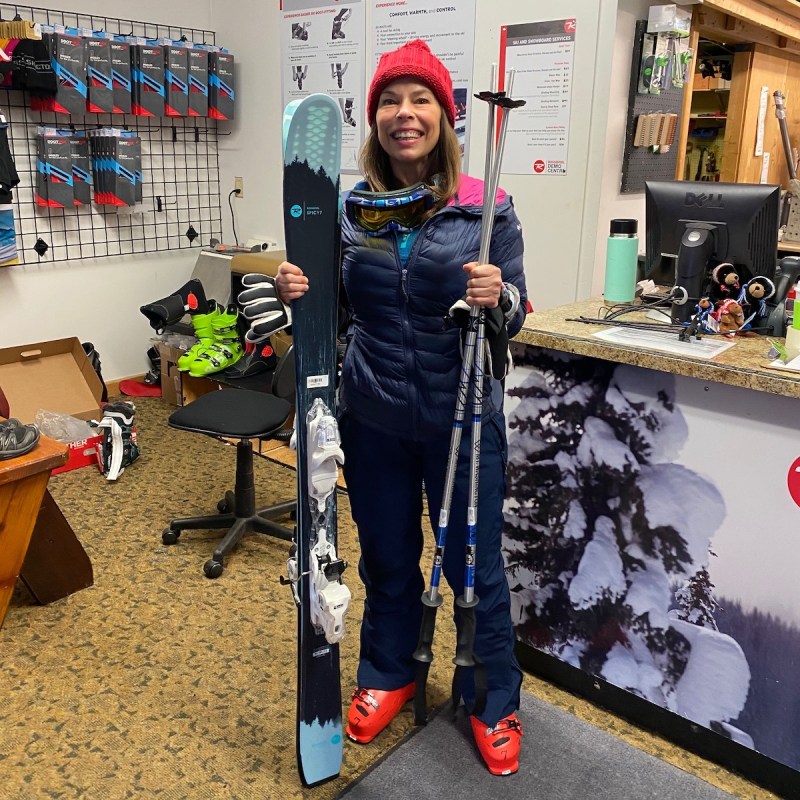
As someone who grew up on the relatively not-snow-covered plains of Oklahoma, I’m a late-comer to the sport of skiing. It’s not that I never wanted to ski or hit the slopes like some fit and fast snow bunny, it’s simply that I never had the opportunity to try skiing.
Videos by TravelAwaits
I never had the opportunity, that is, until I turned 50. Even to me, 50 seemed like a dramatically older age to learn how to strap on skis and hit the slopes, but when I had the opportunity to give it a try at Mount Washington Alpine Resort on Vancouver Island, British Columbia, I eagerly signed up for the resort’s Snow School and its Discover Ski or Snowboard Package.
I was on a winter exploration trip of Vancouver Island with five other journalists, and as a guest of Visit BC, we all had a day to enjoy the snow of Mount Washington, a peak that is famous for having snow deeper than anywhere else in British Columbia, and occasionally deeper than anywhere else in the world!

Because of its impressive snowfall, Mount Washington becomes the second-busiest winter recreation destination in British Columbia; only Whistler Blackcomb Ski Resort beats this destination for numbers.
I also figured it would be a good place to try out skiing for the first time. In addition to the stunning snow-capped views of the surrounding mountains and the Comox Valley, the resort features a few bars and restaurants that I could escape to if I decided I’d had enough.
So, while my fellow travelers — all experienced skiers and snowboarders — hit the slopes with that swaggering confidence of those who have grown up with snow sports, I ventured out with a bunch of toddlers to the little bunny slope for my first lesson.

Hard But Not Harder
Thankfully, the Discover Ski School at Mount Washington Alpine Resort provided all the necessary equipment to learn how to ski for my morning lesson, including skis, boots, poles, and helmet.
My guide, a young fellow who seemed like he was more used to teaching the 5-year-olds, started me out with a quick lesson on how to put on the skis. Trust me, if you’ve never had to put a pair of skis on, you’ll really need someone to show you.
After attaching the skis to my ski boots, we stood in place and practiced foot placement.
“You’ve heard of pizza and french fries, right?” he asked.
I nodded. I may be new to skiing, but I haven’t lived under a rock all this time. In the most basic terms, you “french fry” when you want to go, and then turn your toes in for a “pizza wedge” when you want to slow down or stop.
For the first half-hour or so, we practiced that move on a slope that could barely be called a hill at all — without ski poles.
“I want you to get comfortable using your feet and balance while skiing and not rely too much on the poles,” my teacher explained.
Okay, that made sense. I scooted around in my french fry position, sliding awkwardly about 20 feet or so as I tried to get used to the balance on the skiis. The hardest thing for me to learn was how to stop. The pizza worked to slow me down, but I just couldn’t get the hang of pressing all my weight to the outside of my feet in that position to create a full stop.
After a couple of falls onto my hip, I finally started to sort of get the hang of stopping, and we advanced to using poles.
Once we graduated to the “big girl” poles, we practiced going down the longer bunny slope. I practiced that soft, bent-knee glide and pushed my hips out from side to side to alter my directions. I still couldn’t stop as well as I wanted, and honestly, my calves were on fire from trying.
While expert and even intermediate skiers look as if they are floating easily across the snow, I looked like one of the many toddlers on the slope that day — flailing about or simply sitting down on my bum when I couldn’t get myself to stop.
After a break and lunch, we advanced on to faster speeds, learning how to point my “toes” in the direction I wanted to go and how to “zig-zag” down the slope. At one point, I let my speed take over, relishing in the thrill of going fast down the hill, and I even managed to stop myself, however awkwardly.
I shuffled to the escalator thing that takes you back up to the top of the hill, slid off to the start, and tried over and over again. On some runs, I did perfectly. On most runs, I still fell, fought to brake using the pizza wedge, or slammed into the snow. But it was fun.

Fun In The Sun
The weather at the top of Mount Washington was icy cold, but the sunshine that broke through the gray and dismal clouds mid-morning made the day downright pleasant as I learned to ski. I didn’t need the heavy gloves or even a heavy jacket, and towards the end of my lesson, I was full-on sweating.
And I was having a ball on those little baby slopes. Yes, I’m sure my fellow travelers were zipping like seals down steep slopes, testing their skill against the mountain, but I was just fine where I was.
All my life, I’ve been an adventurous sort, and I’m not shy to try anything at least once. That being said, I do notice that I don’t take as many risks now that I’m a little older. I did worry about injury, specifically breaking my leg on the skis.
It’s not a frivolous thing to worry about. According to the National Ski Areas Association (NSAA), 40.6 people die skiing/snowboarding per year on average. Serious injuries like paralysis and head trauma occur at the rate of about 44.6 per year, according to the NSAA.
With any sport and outdoor fun, an inherent risk for injury does exist. So, if you’re like me, here are a few tips if you want to learn to ski at an older age.

Tips To Stay Safe
- Always wear a ski helmet. According to Dr. Jasper Shealy, professor emeritus at the Rochester Institute of Technology in Rochester, New York, who has studied ski-related injuries for more than 30 years, recent research proves that using a helmet reduces the incidence of any head injury by 30 to 50 percent.
- Don’t take unnecessary risks. Okay, you’re a daredevil and eager to try skiing. That’s fine, but a ski helmet won’t protect you from serious injury or death if you engage in risk-taking behavior simply because you are wearing a helmet.
- Be honest about your ability. At this age, I’m beyond the need to impress anyone, so it was easy for me to admit that I was an absolute beginner. Everyone has to start somewhere, and I’d rather learn to ski in a safe environment than come home with a broken leg or head injury because I was too embarrassed to admit I was a beginner.
- Stay on the prepared runs. Even if you are a more advanced skier, you should stay on the designated runs without a guide. Designated runs are groomed to avoid obstacles that you may not see off-piste, like tree stumps, unstable ice, or rocks.
- Know the code of conduct on the slopes. The FIS (International Ski Federation) has established 10 rules of ski and snowboard conduct that are legally binding, so if you break one of these rules, you can be sued or held accountable for your negligence.
- Wear appropriate clothing. You don’t want to run the risk of frostbite or hypothermia, so be sure to wear layers and appropriate clothing for cold weather. Wicking base layers are best because they move sweat away from your skin. Cotton layers should be avoided because they actually hold moisture. There’s an old saying that “cotton kills on the trail.”
- Take a lesson with a certified teacher and guide. Honestly, you could learn to ski on your own or with Uncle Bob, but it’s easier, safer, and better to take a ski lesson at a resort with a professional ski instructor.
For more skiing inspiration, plus our favorite resorts and slopes around the world, check out all of our skiing content here.
